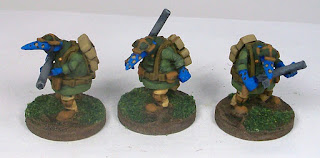I've finished some Companion for my commission. Still have a bit more to go before I complete the whole thing, but I am coming along.
The consensus on the research I have done on the Companions has them equipped as follows:
"Companion cavalry would ride the best horses, and receive the best weaponry available. In Alexander's day, each carried a xyston (long thrusting spear), and wore a bronze muscle cuirass or linothorax, shoulder guards and Boeotian helmets, but bore no shield. A kopis (curved slashing sword) or xiphos (cut and thrust sword) was also carried for close combat, should the xyston be lost or broken."
Having done my research on dress and equipment I based the Companions I have done off of Alexander's Persia Campaign. It wasn't until he conquered Persia that he bestowed lavish gifts and equipment to the Companions.
The paint job I used was based off of this painting.
Of course minus Alexander himself as in the Rule set Saga he is on a Warlord base and isn't leading the charge of his Companions like he would in history.
Here are some fun facts about how many and who the Companions were:
The Companion cavalry was composed of the Hetairoi of the king, mainly upper class citizens who were able to acquire and maintain armour and horses. In the age of Philip II and Alexander they were organized into 8 territorial squadrons, termed ilai. Each ile numbered between 200 and 300 horsemen. They were originally commanded by a single leader, Philotas under Alexander the Great, but following his execution would see the leadership split between two men, Cleitus the Black and Hephaestion. Arrian claims this would be because, Alexander "did not want anyone, not even his intimate friend, to be the centre of attention". After receiving reinforcements in Susa, Alexander established two companies in each squadron. They were referred to by the name of the territory they were mustered in or by the name of its captain. The Royal Ile was commanded by Alexander himself and contained twice the number of soldiers the other units contained, c. 400. These cavalry squadrons would sometimes be combined in groups of two, three or four to form a hipparchy, which was commanded by a hipparch, though the whole Companion force was generally commanded by Alexander.
In Alexander's Balkan campaigns, we find mention of Companions from upper Macedonia, the central Macedonian plain and Amphipolis. During the advance on Granicus, a squadron commanded by Socrates of Macedon (not to be confused with the philosopher) hailed from Apollonia on Lake Bolbe. During the Battle of Issus, Arrian names the ile of Anthemus (modern Galatista),; another, from the unidentified land of Leuge (likely Pieria), is also mentioned.
Theopompus describes the Companions, probably of around the mid 4th century BC, as being made of "no more than 800 at this time" and mustered "some from Macedonia, some from Thessaly and still others from the rest of Greece". By 338 BC, Alexander is reported to have had around 2600 in his Companion Cavalry As Alexander's force campaigned towards India, barbarians played an increasing role in the Companion Cavalry and the Macedonian mutiny at Opis may have been partially caused by this. At one point, there were four hipparchies made up of entirely oriental forces and one that was a mix of Macedonians and orientals.
In battle, Alexander the Great personally led the charge at the head of the royal squadron of the Companion cavalry, usually in a wedge formation. In a pitched battle, the Companions usually fought on the right wing of the Macedonian army, next to the shield-bearing guards, the hypaspists, who would guard the right flank of the phalanx. Other cavalry troops would protect the flanks of the Macedonian line during battle. Under Alexander's command, the Companions' role was decisive in most of his battles in Asia
...and now some pretty pictures of my interpretation of the Companions.
As always thanks for looking.
Cheers
Kevin
















